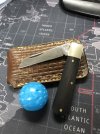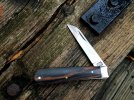Good morning Guardians. Just got back from my trip up north to Pennsylvania. Got to see all my kids and had a wonderful time. Hope you all are doing well. I've got my HHB with me again but no new photos. Recycled picture I'm afraid.
View attachment 1983473
Glad you had a great trip Bill, that pic has plenty of vitamins!


Thanks, Jack! I’d read about some of those Nowill tang stamps in my research, neat to see the photos. The crossed keys are most excellent! Do you know if there’s a way to tell if a knife is pre- or post-sale in 1947? I read that the quality went a bit downhill after the Great War, and then again more significantly post-WWII, hence my wishful thinking that this one might be from between the wars.
It's a nice mark isn't it?

Ordinarily, it would be almost impossible to tell that I'm afraid, even if a company had become a limited company in 1947, for example, it wouldn't automatically follow that their tang stamp would change, or at least, that it would change that year. With the exception of silver-bladed fruit knives, it's rare to be able to date a Sheffield knife to a particular year, but sometimes it's possible. What muddies the waters unfortunately are the large number of liars and charlatans selling knives on ebay, giving dates which are very often wildly inappropriate. A few folks, who should know better, also cause confusion, by making wild guesses, based largely on wishful thinking. Generally, we're all guessing, to a greater or lesser extent, when it comes to dating Sheffield knives, and while there's a huge difference between an informed guess and an uninformed one, we need to be honest. The quality of Sheffield cutlery certainly went downhill after WW1, in large part because of the huge number of Sheffield cutlers killed in France, and it went downhill again after WW2, for much the same reason. There were added factors too though, shrinking global markets, and increased foreign competition, caused the Sheffield cutlery companies to try and reduce costs, which led to a decline in quality. The jobs market had changed, and fewer lads wanted to enter a badly-paid occupation, which was clearly in decline, and most cutlers didn't want to take them on as apprentices, because they were able to make less knives themselves. Apprentices were often used as cheap labour, receiving second-rate training, from increasingly second-rate cutlers. Cutlers like Stan Shaw, who didn't go into the trade until the latter part of WW2, are very much the exception, rather than the rule. Stan was lucky to find a great old cutler to train him, but if he had had any formal education, he'd probably have done something else. Your knife MIGHT be from between the wars (1918-1939), in many ways it has a 30's style, even though the off-centre blade speaks against that. Nowill started to go into decline from the 1920's onwards, and like all Sheffield firms, would have used some outworkers, which could explain such an obvious flaw, but it could have been a 'waster', or a knife assembled later from older parts. Further research, in terms of catalogues, may indicate when Nowill began using a simplified tang stamp. Nowill were still using their marks on folding clasp knives made during WW2. They were very proud of the marks, and the change to a simplified stamp, without the cross-keys and *D marks, may well have happened after 1947, when the company ceased to be family owned. That would be my guess, but it's a guess

I came across a couple threads here with videos of folks centering/crinking blades with a block of wood and a mallet and decided to give that a go myself, but the thing didn’t move a millimeter! I’m trying to get better about knowing when to leave well enough alone instead of doing more harm than good, so I’ll probably just learn to live with the blade rub; it looks terrible in the pictures but in practice is still useable.
I remember seeing at least one of them, and also seeing an explanation, possibly from Eric Albers, which made it sound more simple than I would have imagined. That said, I used to regularly see Stan Shaw crinking blades, with a hammer and stiddy, and it looked a VERY simple affair

You might get some good advice in the maintenance and tinkering section, and there are certainly skilled members who could put that blade right for you

I'm not carrying a Lambfoot today - at least not yet but this two-blade would be appropriate in the snowy weather we're having.
View attachment 1983477
Looks good Ed

Spectacular colours John



This is hopefully a link to YouTube video that shows how to center a off centered pocket knife blade. I’ve used it several times with success.
Interesting

I'm glad it's worked for you my friend, I guess there's always more than one way to fix a problem

I have to say, I wouldn't let that feller BORROW my knife!



I’d be interested in your thoughts regarding the output that Jack Adams Ltd. produces. That’s a handsome Lambfoot, Jack. Have a good day.
Prior to Jack passing away a few years back, he was the oldest working cutler in Sheffield. The company has an interesting range, but they specialise in fixed blade knives, of all types, and have the few folding knives they sell made for them. I believe A. Wright currently make their Lambsfoot knives, which are produced with the generic 'Sheffield' tang stamp, and some members have found them to be of better quality than the ones brought elsewhere

Thanks buddy


Patron saint, indeed. Good of you to share with the Guardians. His books on this subject are a must for the serious collector.
Geoff's books are definitely a must Harvey, and the P.O.D. issues are great value I think

Good Morning Guardians


A great pic my friend, and a fab-looking Saynor


This post has taken me WAYYYY longer than anticipated, and I'm running behind here, as I'm going out, and also have the market tomorrow, but I'll try to post later if I get a chance


Hope everyone is doing well. No chance of sneaking down to Charlie's cafe for me today I'm afraid, but I'm meeting a pal for a couple of pints tonight
Got Big Rose in my pocket for now
Have a good day Guardians










